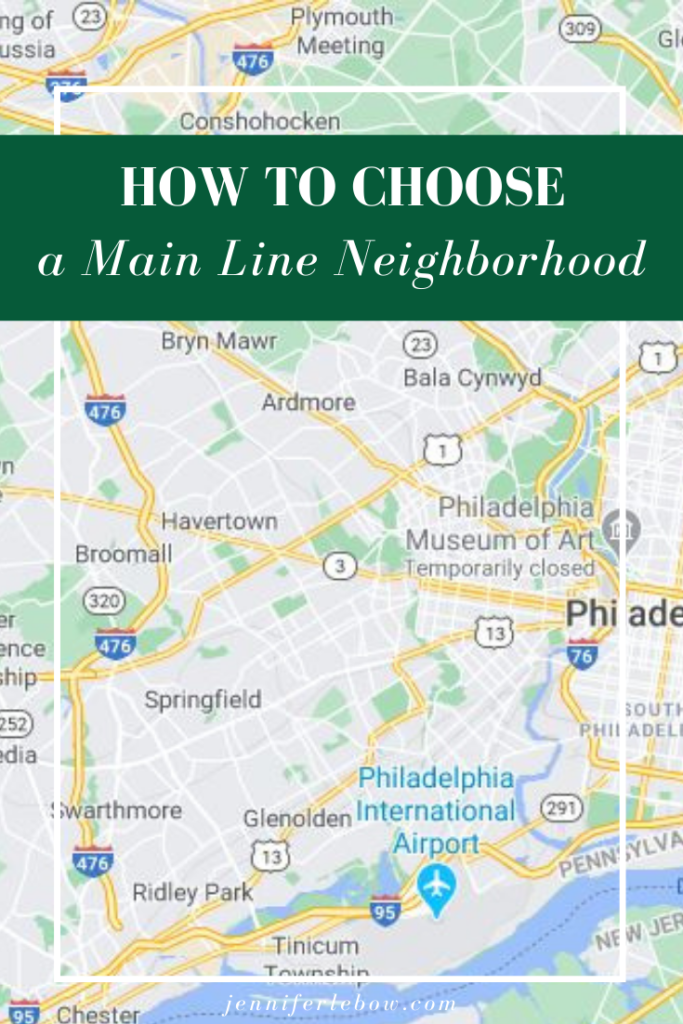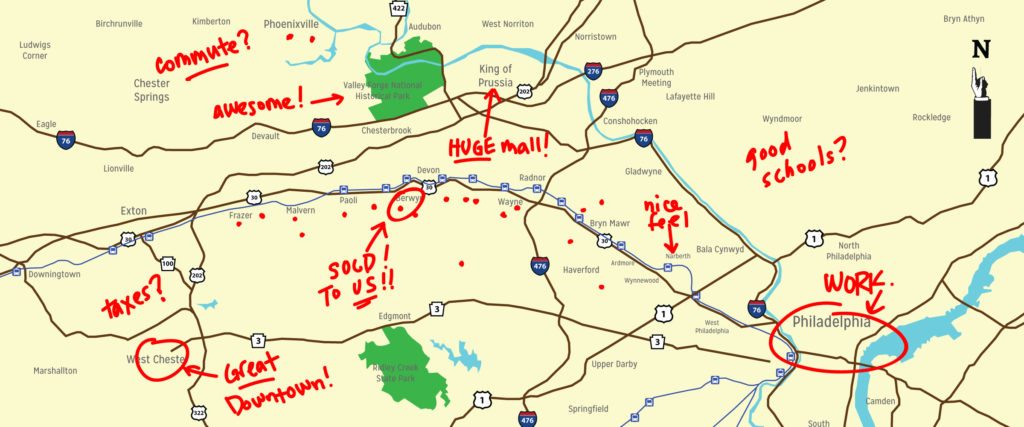
You’re strongly considering a move to the Main Line. You may have heard that the public (and private) schools are great and that the landscape is beautiful. You might have looked on line and seen stone homes that drip curb appeal. Your commute, if you have one, could be reasonable from many Main Line communities. So how do you narrow down which areas you should consider for a home purchase?
Location
The first step is to learn a little bit about the different towns along the Main Line and what factors you should consider when choosing a location. Since location always comes first in real estate, let’s tackle that subject. You’ll want to know how easy/quick it is to get to where you want to go, whether that’s work, the airport, your sister’s house, Whole Foods, the playground, etc. For some people, school district is very important as well. Many buyers want to be near the train. Look at the map: it will show you where the highways and main arteries are. Are you worried about noise? You should plan to steer away from homes very close to them.
Zeroing in on the smaller, more immediate neighborhood (like the street/block a home is on), what is important to you? Being able to push a stroller or walk your dog? What about how much interaction there is among the neighbors? Some streets have block parties, babysitting swaps or book clubs.
Cost
Obviously, you can’t buy a house if it’s outside of your budget. Beyond that, though, ask your agent what values are doing in a specific neighborhood. Rising? Falling? Are people tearing down and rebuilding or putting on additions? That sort of information may give you a glimpse into how the neighborhood might be changing over time. You also want to know the current range of values there. It’s never a good idea to purchase the most expensive house in the neighborhood, unless resale is not important. Another hidden cost which can be tied to the neighborhood is the tax burden. Be sure to know what that looks like, along with any HOA fee that may exist.
Home style and acreage
Some streets have houses that were built as part of a development (even 50 years ago) and have a similar feel. Split levels, for example might dominate certain areas, while stone colonials may be much more common in another neighborhood. As far as lot size, there is usually less difference between different properties on the same street due to zoning regulations. For example, if you’re looking for a larger parcel, then certain Main Line neighborhoods might not work for you, even if you find a house you like there. If you want your kids to play with the neighbors’ kids and easily go from one house to the next, you might want to avoid neighborhoods with big lots.
How does the neighborhood/house feel?
I always tell my buyers that the most successful home purchases are the ones that were arrived at both analytically and emotionally. What I mean, is that the quantifiable criteria, like number of bedrooms, square footage, distance from work, etc. need to be met or you are likely to experience buyer’s remorse. Just because a house is charming, it doesn’t mean it will meet your needs. Charm can wear off quickly, if the layout/size/location don’t work well for your family. Conversely, leave room in your decision-making process for the visceral “this feels like home” reaction. Pay attention to how it feels riding down the street as well as in the house and on the property.
Who would my neighbors be?
This question, usually an innocent one, is asked of me by almost every buyer. Please understand, that, according to the Realtor’s Code of Ethics, we as agents are not permitted to discuss age, race, family type, or any other protected class information. Some people are specifically looking for diversity, while others don’t want to be the only __________ family on the block. Usually, the question revolves around whether there are kids on the block. Again, it’s usually asked with no bad intent. I recommend driving around the neighborhood and looking for play equipment, basketball hoops, kids’ bikes or chalked driveways if you want to know about kids. If demographics about education and income are important to you, there is data available on line. Also, the particular set of neighbors on the block at any moment is simply the people who live there currently. There’s no way to know who might live there five years from now.
If you are relocating to the Philadelphia/Main Line area, please go to my blog page and search for posts using the relocation tag. Contact me to discuss your Philadelphia area relocation! jen@jenniferlebow.com/610 308-5973


Leave a Reply